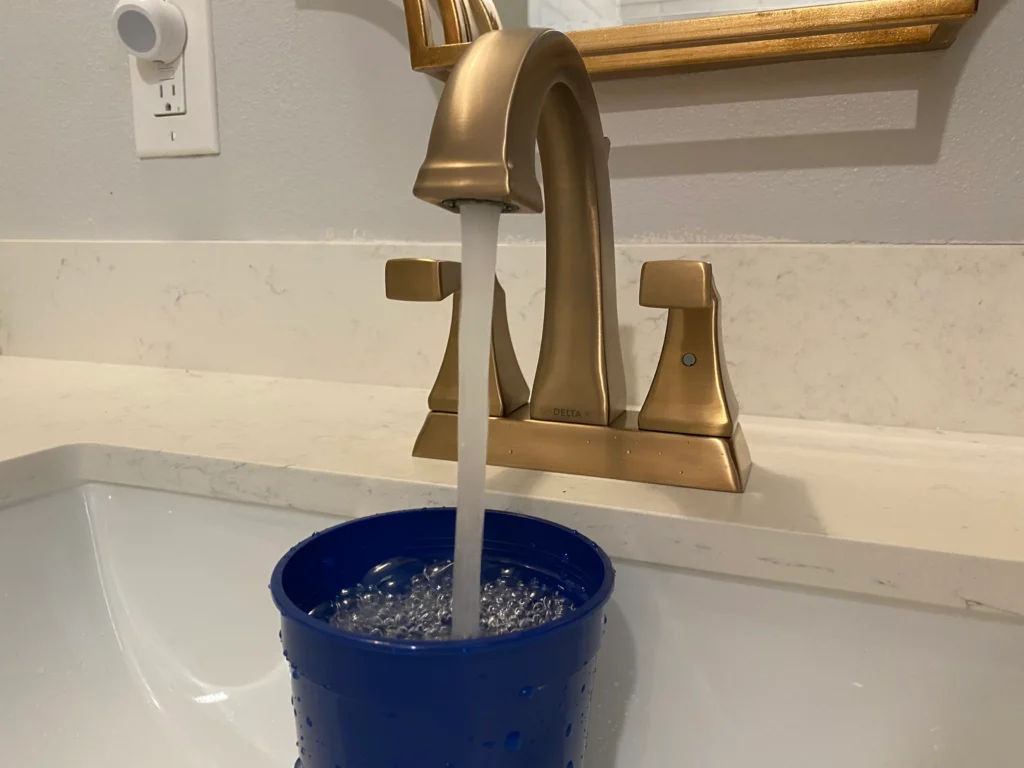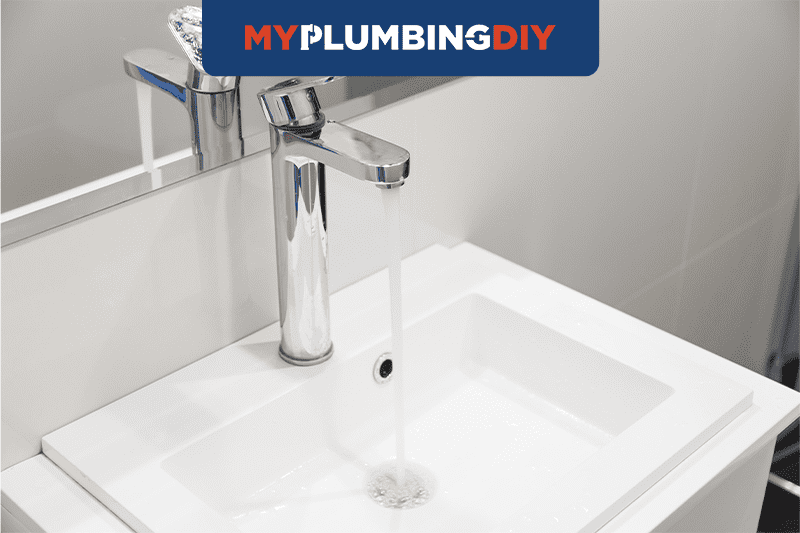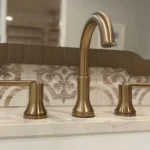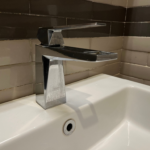This post may contain affiliate links. If you use these links to buy something we may earn a small commission. Thanks.
Have you ever wondered how faucet water temperature remain constant? Well, it’s all down to faucet cartridges.
Faucet cartridges are just one of four types of faucets: ball, disc, compression, and cartridge.
Within the faucet cartridges, there are two different types: ceramic and thermostatic.
But what are they?
In this article, I’ll cover what faucet cartridges are, the two types of faucet cartridges (and how they work), as well as signs of wear and tear that you should always keep an eye out for.
Let’s get into it!
- What is a Faucet Cartridge?
- How Does a Faucet Cartridge Work?
- 2 Types of Faucet Cartridges
- Differences Between 1/2″ and 3/4″ 20-Point Cartridges
- Differences Between 16-Point and 20-Point Cartridges
- Signs of Cartridge Wear and Tear
- Common Question about Faucet Cartridge Types
- The Verdict: Ceramic Disk or Thermostatic Cartridge, What’s Better?

What is a Faucet Cartridge?
The cartridge is an essential component of a faucet’s overall performance. Taking on a huge role, this small part has the responsibility of managing the flow and mix of water that enters it.

What’s the Difference Between a Valve and a Cartridge?
Although they may seem similar at first glance, these two items have significant contrasts when it comes to their design, purpose, types, installation, and upkeep.
While a valve’s primary purpose is to manage the flow of water, cartridges are designed to control and regulate the temperature of the water that is being used.
How Does a Faucet Cartridge Work?
A faucet cartridge is integral to the valve system, providing structural support and enabling the faucet to perform its water regulation functions.
When the handle on the faucet is rotated, it initiates the cartridge to control the water flow from the faucet’s valve. It regulates the water temperature that is emitted from the holes by facilitating the flow of both cold and hot water from each inlet.
Faucet cartridges are popular on single handle faucets because they control both hot & cold water. Stem faucets on the other hand only control one or the other so they are popular in two handled faucets. Both can be used in different kinds of bathroom faucets and types of kitchen faucets.
2 Types of Faucet Cartridges
1. Quarter turn ceramic disk cartridges
A ceramic disc cartridge is composed of two ceramic discs with a number of small, circular openings drilled through them.
How it works
The tap handle is connected to one disc which is firmly fixed in place, while the other disc is able to move in unison with it.
When the two discs are correctly aligned, the water system is opened up and permitted to pass through the tap.
As soon as the pipes are no longer in the same alignment, the water stops moving.

2. Thermostatic cartridges
Thermostatic cartridges are cylindrical fixtures typically constructed from either ceramic or metal that are considered a necessary element of the mixing valve.
How it works
The cartridge contains an element that is sensitive to the temperature of the water.
Its size will fluctuate in accordance with the temperature it is subjected to, functioning in conjunction with a piston that is responsible for managing the flow of both hot and cold water.
Differences Between 1/2″ and 3/4″ 20-Point Cartridges
Aesthetically, the most distinguishable difference between a 1/2” and 3/4” 20-point cartridge is the thread size which determines the diameter of the hole the cartridge or inlet hose is designed to fit into.
In residential homes, a 1/2” is considered a standard size, while a 3/4” is thought of as a medium size.
What size you opt for is ultimately determined by how much water you need, since the size carries a direct correlation to the quantity of water.
Differences Between 16-Point and 20-Point Cartridges
Two common quarter-turn ceramic disk faucet cartridges are the 16-point and 20-point varieties, which vary in their shape, size, and number of ridges, grooves, or splines on the stem.
The splines on the cartridge must be compatible with those on the faucet handle.
In terms of functional purpose, a 20-point cartridge, generally speaking, requires less rotation to turn on – this can result in a higher degree of accuracy and control when it comes to water flow and temperature.
Signs of Cartridge Wear and Tear
Indicators for replacing quarter-turn ceramic disk cartridges
If your faucet has been in use for a while and you notice any of the following signs, it is likely time to switch out one or both of the cartridges:
- If the handle is in the off position but you are experiencing a leak
- Once smooth and seamless, the handle of the faucet is now difficult to twist and turn
- The temperature of the water has become increasingly unpredictable, sometimes reaching extreme highs or lows.
Indicators for replacing thermostatic cartridges
If your thermostatic valve system is older than a few years and you are experiencing any of the following signs, it is highly likely that you will need to replace the thermostatic mixing cartridge:
- The temperature fluctuates when in use
- Water is not reaching a temperature high enough, even when the lever is turned to its maximum setting
- The flow of the water has become inconsistent and difficult to predict.

Common Question about Faucet Cartridge Types
When it comes to how long a faucet cartridge typically lasts, it depends on a few factors. Depending on the brand, how well it’s maintained, and the quality of the water, your cartridge could last for anywhere from 15–20 years.
There are a few signs that a faucet cartridge needs to be replaced. These include sudden changes to the water temperature, flow consistency, and whether any leaks are apparent.
If you notice these – all signs of general wear and tear, as well as mineral deposits, and localized corrosion – you may need to look at either repairing or replacing your cartridge.
While replacing your faucet cartridge can be done by yourself, it’s important to note that in some cases you will need to hire a professional. Simple repairs are easily done, but some manufacturer warranties may require a licensed plumber to complete the task.
When choosing the right faucet cartridge for your needs and budget, you’ll need to consider carefully. While thermostatic cartridges are traditional for showers, ceramic discs are both longer lasting and potentially better value for money.
If you aren’t sure, consult a professional and ensure you check the manufacturer’s warranty pre-purchase.
The Verdict: Ceramic Disk or Thermostatic Cartridge, What’s Better?
Which is best is dependent on your needs and the type of faucet the cartridge will be paired with. However, one of the things that should be taken into consideration is the water supply that feeds the faucet.
Ceramic discs are known to wear down at a much faster rate when the water supply has been contaminated by hard water and/or excessive sediment.
On the other hand, a thermostatic cartridge can be rendered inoperable due to a build-up of limescale and dirt.
Personally, I’m a fan of ceramic discs as they offer a much more affordable long-term solution. Additionally, the technology seems to be improving all the time!
However, whether you choose a ceramic disk or thermostatic cartridge, you can be sure that you will have made a great choice for your home.


